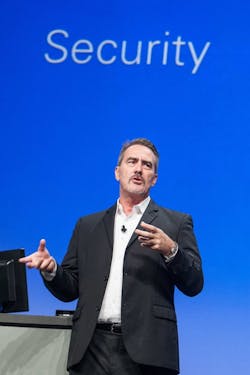Mike Bacidore is the editor in chief for Control Design magazine. He is an award-winning columnist, earning a Gold Regional Award and a Silver National Award from the American Society of Business Publication Editors. Email him at [email protected].
[sidebar id=3]
Austin, Texas, experienced its 21st annual surge in engineering and science thought leaders, as National Instruments hosted more than 3,000 thought leaders at NIWeek in August.
Speedy innovation and productivity were at the epicenter of the conference’s collection of keynote speeches, technical sessions and expo-floor demonstrations, with the Industrial Internet of Things (IIoT) taking center stage.
In his keynote presentation at NIWeek, IBM’s Greg Gorman said we’re just scratching the surface of the IIoT.
“We’re just scratching the surface,” said Greg Gorman, director, IoT solutions group, at IBM, which has earmarked $3 billion in IoT investments. Gorman was one of the keynote speakers at NIWeek, where he talked about the benefits of cognitive computing. “A smart city will be able to manage traffic differently,” he explained. “And we’ll be able to attack things such as aging.”
Another keynote speaker, Dr. Andrea Goldsmith, professor of electrical engineering at Stanford University, referenced the explosive growth she’s seeing in the number of devices being connected wirelessly. But for industrial applications, it raises issues. For example, to control a robot wirelessly, you need low-latency communications, high-quality visuals, real-time sensor data and tactile response times. “We can’t even get Youtube to work reliably over a wireless network,” she cautioned. We need to make wireless networks more reliable.”
Imagine a whole new range of sensors in factories connected to the cloud to optimize production, suggested Goldsmith. “Software in the cloud will allow us to run these systems more effectively,” she predicted. “One big challenge is that the IoT will drive thousands of times more devices. “We’ll have low-power, low-data-rate sensor devices, which will require new technologies to make batteries last longer.”
Mark Cudak, principal research specialist at Nokia was one of many speakers who mentioned predictions of 50 billion devices connected to the IoT by 2025. “How will the devices work with the network?” he asked. “We want lower latency and higher throughput. 5G will bring mission-critical data.”
Cudak is part of a team that’s been using NI’s LabView platform to develop millimeter-wave (mmWave), or extremely high frequency (EHF), communications in a 5G network.
“We have the LabView platform,” said Cudak. “We exceeded our expectations from concept to prototype. We were able to take LV and PXI and create the fastest mmWave technology to date.”
NI unveiled LabView 2015 system design software, the new PXI-based wireless test system and other additions to its data acquisition and embedded systems hardware platforms at the event, as well.






